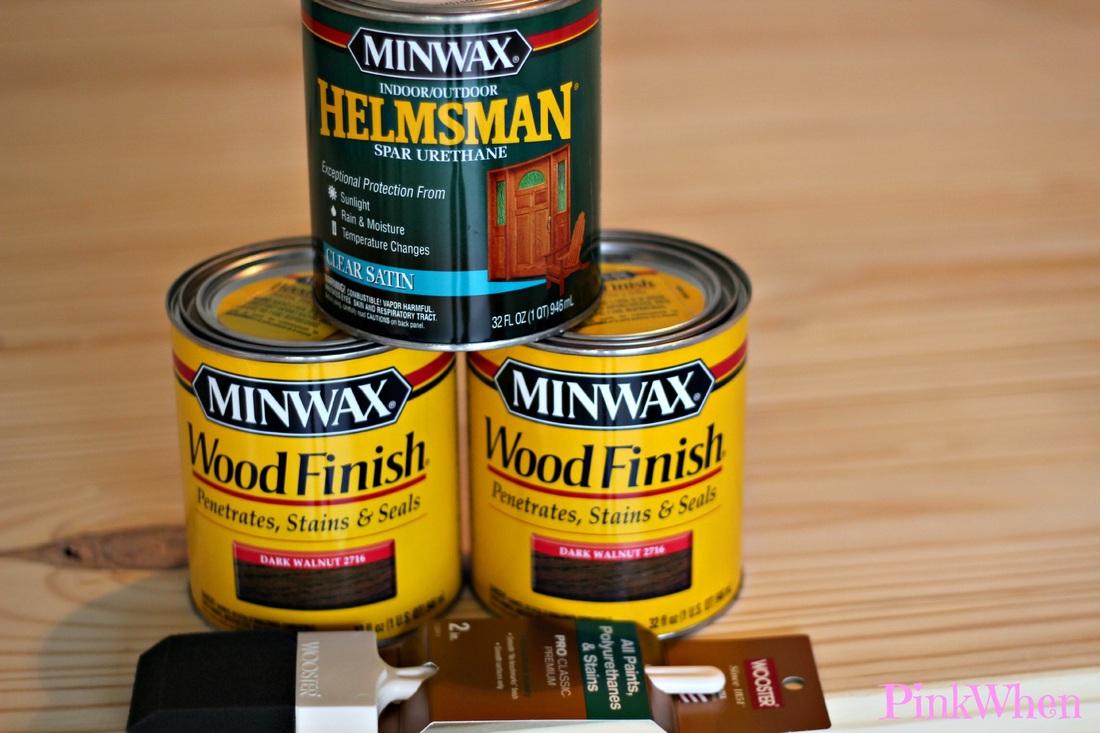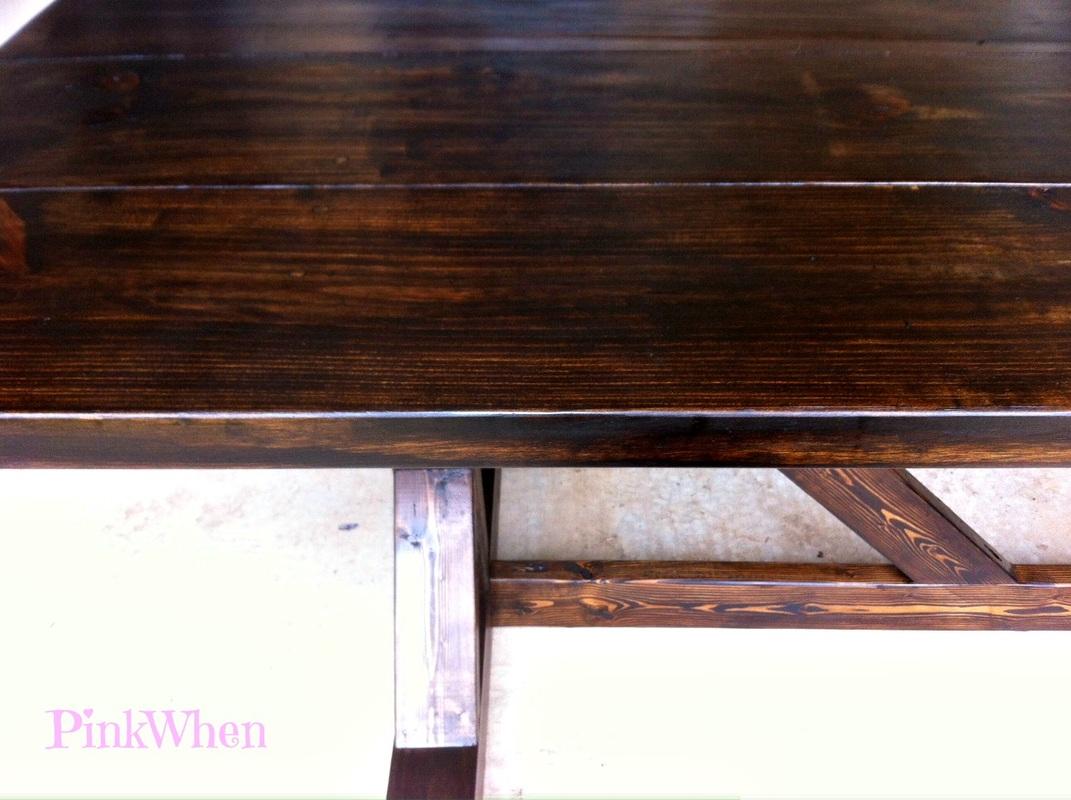
 Building this Farmhouse Table was a lot of hard work, but also a lot of fun. I was amazed at the sites where people were saying they had this built in 4 hours, or something amazing like that. It took us 4 hours just to precut the wood for the project!
Building this Farmhouse Table was a lot of hard work, but also a lot of fun. I was amazed at the sites where people were saying they had this built in 4 hours, or something amazing like that. It took us 4 hours just to precut the wood for the project! It then took both my husband and I three days to build, and then another two days to stain, dry, stain again, dry, finish, dry, and finish again. While we did not work on it every day full time, there were days where we did work for hours. To get started where we left off from part one, it's table top time! This is where you are also going to get a LOT of use out of your Kreg jig, and a fun little drill bit that makes wood pieces to plug the screw holes on top. We opted to do that rather than use nail heads. We wanted as smooth of a table top as possible.
First, let's get started with how we assembled the top. We measured and placed pocket holes on the underside of the table top, these were every twelve inches. Now I am sure you don't have to do this many, but we wanted to make sure this thing would withstand almost anything, and for a long time.
 Pocket holes using the Kreg On the adjacent board we did the same, so when you placed the boards together you had a pocket hole every six inches. This table top really isn't going anywhere!
Pocket holes using the Kreg On the adjacent board we did the same, so when you placed the boards together you had a pocket hole every six inches. This table top really isn't going anywhere!  Pocket holes with the Kreg Once you complete this step and get your boards attached, it is time to flip it and attach it to the top.
Pocket holes with the Kreg Once you complete this step and get your boards attached, it is time to flip it and attach it to the top.One of the other things we decided to do was cover our holes and bright blue screw heads with plugs. We didn't want nail heads on the top of the table, so we opted for these instead. We also did this on the legs of the table. Here is a quick "how to".
 We used the self centering drill bit to create these plugs, and a flat head screw driver to pop them out.
We used the self centering drill bit to create these plugs, and a flat head screw driver to pop them out.  Then take a scrap piece of wood to tap the plug into the hole.
Then take a scrap piece of wood to tap the plug into the hole. The drill bit also created a little hole in the plug piece (see above), so make sure that is the end with the hole that goes in first.
Using a spare board to hammer these in place ensures you aren't leaving hammer marks on your table.
 Filling screw holes When you have finished with all of the holes, you should have this beautiful table below.
Filling screw holes When you have finished with all of the holes, you should have this beautiful table below.Make sure you sand, sand, sand and get everything smooth. Always sanding with the grain, never against it.
When you have finished sanding, brush the table off, and then take a damp clean cloth and wipe off any excess remnants from sanding.
 FInished, yet unfinished For the stain and finish I opted for the Minwax Dark Walnut, and put two coats on. I love this stain, and had a feeling it was going to turn out beautiful. For the finish I used 2 coats of the Helmsman Spar Urethane Clear Satin.
FInished, yet unfinished For the stain and finish I opted for the Minwax Dark Walnut, and put two coats on. I love this stain, and had a feeling it was going to turn out beautiful. For the finish I used 2 coats of the Helmsman Spar Urethane Clear Satin. I chose clear sating because I did not want a shiny finish. This is going to be out doors, and I thought it would look better with a muted finish. It turned out perfect!
 Stain and Finish Choices I also chose the foam brush because I did not want any possible lines in the stain or finish, and think this helped get a more even coat over everything. Read the instructions on your stain. You don't just paint this on. You brush this on, let it sit for 5-15 minutes, and then you take a clean rag and wipe off any excess stain. Then allow it to dry for 8 hours before applying another coat.
Stain and Finish Choices I also chose the foam brush because I did not want any possible lines in the stain or finish, and think this helped get a more even coat over everything. Read the instructions on your stain. You don't just paint this on. You brush this on, let it sit for 5-15 minutes, and then you take a clean rag and wipe off any excess stain. Then allow it to dry for 8 hours before applying another coat.  Applying the first coat Finally finished! It turned out gorgeous.
Applying the first coat Finally finished! It turned out gorgeous.  A picture of the top. See all of those holes? Nope! They are hard to find, and filled in and stained really well.
A picture of the top. See all of those holes? Nope! They are hard to find, and filled in and stained really well.  Love how it looks on our patio.
Love how it looks on our patio.  Easily dressed up, or just as gorgeous with nothing on it.
Easily dressed up, or just as gorgeous with nothing on it.  Love our new table, and love that we made it.
Love our new table, and love that we made it.  After all of that hard work, we realized we were missing something very important.
After all of that hard work, we realized we were missing something very important. Seating!
We are going to make some benches to go along with it. I will post that here to link up as soon as they are finished.
Thanks for following along with our build, and thanks to Ana White for creating this easy to follow plan.
Are you following me yet? You can follow me onPinterest, Facebook, and Twitter!

